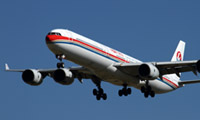Cover Story
SURPRISE, SURPRISE
Hong Kong was Asia’s last budget airline free zone. But last month that changed when it was announced that regional operator, Hong Kong Express, was to re-launch as a low-cost carrier in October. It’s a blow for a China Eastern/Qantas joint venture which has been trying hard to get a foot in the door for some time.
July 1st 2013
Shanghai-based China Eastern Airlines (CEA) and Qantas Airways have been trying for more than a year to establish a low-cost carrier (LCC) in Hong Kong. But there have been serious questionmarks raised, not least by incumbent Cathay Pacific Airways, about whether civil aviation authorities should grant an air operator’s certificate (AOC) to an airline essentially owned and managed by interests outside the city.Read More »
 |
| 'We’re finding ways to compete effectively. As long as we are attracting consumers to Cathay we are likely to stick with that' |
| John Slosar Chief Executive Cathay Pacific Airways |
But last month, in a bid to sway opinion and obtain an AOC, the partners recruited a local partner into their proposed joint venture, Jetstar Hong Kong. A 33.3% stake was sold to property and transport conglomerate Shun Tak, founded by Macau casino tycoon Stanley Ho, for US$66 million.
But in a surprise move only days later, CEA and Qantas’ seemingly brazen tactics were trumped by local carrier Hong Kong Express, in which, ironically, Shun Tak also has a 25% interest, when it was announced it would be re-branded and launched as an LCC in October.
Majority-owned by Mainland China’s Hainan Airlines Group, Hong Kong Express has been flying out of Hong Kong as a regional operator since 2006 and is a sister carrier to Hong Kong Airlines.
The question now is what happens next for the CEA/Qantas project? Will the powers that be in Hong Kong accept that a local investor is enough to justify that Jetstar Hong Kong is a locally “owned” carrier, especially as the new investor also has a stake in what would be one of its chief rivals?
The Hong Kong authorities, according to insiders, want an assurance that Jetstar Hong Kong won’t be an airline essentially controlled from Sydney or Shanghai.
Hong Kong’s Civil Aviation Department (CAD) is refusing to approve new carriers while deciding how application procedures for an AOC should be interpreted in respect to ownership and, more importantly, control.
Lingering doubts about whether Jetstar will meet CAD requirements have led to a delay in its planned launch from mid-2013 to later in the year.
 |
| China Eastern Airlines: Beijing has given permission for its Jetstar Hong Kong joint venture with Qantas, but the new carrier still needs an AOC |
The problem for Jetstar Hong Kong, which has received Mainland Chinese approval from Beijing, but not the all-important Hong Kong AOC, is that the law is far from clear cut.
In April, Hong Kong’s Transport and Housing Bureau gazetted revised Air Transport Licence Application guidelines. However, the definition of a local carrier under the Hong Kong Special Administrative Region’s (SAR) Basic Law remains unclear and depends on the discretion of Hong Kong officials.
Although Hong Kong has no local ownership requirements, it does stipulate a carrier must have its principal place of business in the SAR. Cathay, which is opposed to Jetstar Hong Kong’s application, has vaguely suggested Jetstar’s launch would require a change of law or reciprocity agreement with Australia, Jetstar’s base. It clearly believes the new operator’s principal place of business in terms of management will, in reality, be Sydney.
Qantas Group chief executive, Alan Joyce, believes the venture will be given the green light before the end of the year. Last month, he said the airline’s new investor, Shun Tak, was a well-established presence in the local market and has a range of tourism and travel interests that align well with Jetstar Hong Kong.
“This will add to the strategic partnerships we have across Asia, with companies that have chosen to invest in the Jetstar brand,” he said before the Hong Kong Express announcement. “There is clear potential for a local low-cost carrier in Hong Kong to stimulate new travel demand, particularly given the proximity to Mainland China and the ability to connect with existing parts of the Jetstar network.”
In the last year, the airline has built up a local management team and started pilot and cabin crew recruitment.
Joyce, along with Jetstar executives, has refused to comment since the Hong Kong Express announcement.
In February, Jetstar Hong Kong announced the appointment of Edward Lau as chief executive. He was previously managing director of TNT in Hong Kong and was part of the team that established FedEx in Asia.
Four of the airline’s six directors are Hong Kong residents. The other two are Jetstar group chief executive, Jane Hrdlicka, and chief commercial officer, David Koczkar. Their presence, analysts suggest, will ensure the Hong Kong head office can maintain influence over the running of the carrier.
Consultancy CAPA said a Jetstar launch would clear the way for other prospective entrants. Japan’s Peach Aviation, part-owned by All Nippon Airways, and China’s Spring Airlines, have declared an interest in potential Hong Kong affiliates.
In the face of this potential local onslaught of LCCs in its home market, Cathay, which has refused to jump on the budget bandwagon, remains stoic.
Commenting on Jetstar Hong Kong, Cathay chief executive, John Slosar, told Orient Aviation: “It’s a decision for the Hong Kong government. We at Cathay get on with our business and do what we can to make it better each day.
“There are rules and regulations in Hong Kong and, in general, no airline can go anywhere and say they would like to set up. That’s not how international aviation works at the moment.”
Slosar stressed again that Cathay had no plans to launch a budget subsidiary to compete with new LCCs. “What we are doing at the moment seems to be working well for us,” he said.
“We’re finding ways to compete effectively. As long as we are attracting consumers to Cathay we are likely to stick with that.”
Nevertheless, it is known that Cathay has been lobbying authorities to press the point that Jetstar Hong Kong does not currently meet local requirements.
Meanwhile, Jetstar Hong Kong has reduced its launch fleet from three to two A320s, but has said it will introduce 18 aircraft in the first three years of operation.
In the final analysis, most industry insiders believe Jetstar Hong Kong will eventually take to the skies.
| Hong Kong LCC traffic trailing other hubs Whatever the outcome of the Jetstar Hong Kong AOC application, the authorities in the Hong Kong Special Administrative Region (SAR) are confronted with a dilemma. They know the SAR is lagging behind other regional hubs in LCC traffic volumes. Across Asia budget operators control nearly 25% of all traffic. In some countries it is considerably higher. In Thailand, some 53.5% of all domestic traffic was carried by LCCs last year. In the Philippines, eight out of 10 seats flown in the domestic market were LCC seats. In Hong Kong, budget operators on international routes accounted for 5% of the market. LCC supporters argue this low penetration has constrained growth and while the average yearly increase in passenger numbers in Hong Kong was 3.7% between 2008 and 2011, it was 7.3% in Singapore and 11% in Kuala Lumpur. On the other hand, questions have been raised about the ability of Hong Kong International Airport, already facing congestion issues, to handle a surge in new traffic. A third runway is to be built at a cost of around $17 billion, but is not expected to be operational until 2020. |